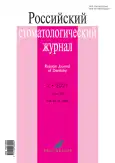Оценка стоматологического статуса и показателей электромиографии жевательной группы мышц у лиц молодого возраста, занимающихся физическими нагрузками с утяжелителями
- Авторы: Насибуллина Э.Ф.1, Кабирова М.Ф.1
-
Учреждения:
- Башкирский государственный медицинский университет Минздрава России
- Выпуск: Том 25, № 2 (2021)
- Страницы: 151-157
- Раздел: Клинические исследования
- Статья получена: 21.03.2021
- Статья опубликована: 15.03.2021
- URL: https://rjdentistry.com/1728-2802/article/view/63822
- DOI: https://doi.org/10.17816/1728-2802-2021-25-2-151-157
- ID: 63822
Цитировать
Полный текст
Аннотация
Актуальность. Высокие эмоциональные и физические нагрузки спортсменов, особенно в период подготовки к соревнованиям с использованием утяжелителей, оказывают влияние на отдельные органы и ткани человека и не до конца изучены в настоящее время. На фоне изнуряющих и длительных нагрузок, особенно у спортсменов, работающих с отягощениями, зубочелюстные аномалии встречаются чаще, кариес и некариозные поражения зубов, воспалительные заболевания пародонта, травмы челюстно-лицевой области также находятся на более высоком уровне. Исследования последних лет выявили, что подобные поведенческие факторы приводят к более высокому риску возникновения заболеваний полости рта. Это объясняется воздействием одонтогенных очагов хронической инфекции на системный иммунитет и приводит к снижению результативности спортивных достижений, а также доказывает значимость своевременного контроля и оценки стоматологического статуса данной группы населения, проведения основных и дополнительных методов диагностики стоматологических заболеваний, профилактики и лечения.
Цель — оценить стоматологический статус и показатели электромиографии жевательной группы мышц у лиц, занимающихся физическими нагрузками с утяжелителями.
Материал и методы. Обследованы 115 молодых людей мужского пола в возрасте 25–35 лет. Их них 70 молодых людей активно занимались физическими упражнениями (бодибилдинг, пауэрлифтинг, тяжелая атлетика), 45 не имели отношения к спорту. Оценивались данные осмотра, расспроса, результаты дополнительных методов обследования, дана индексная оценка состояния полости рта. Электромиографическое исследование позволило изучить функциональное состояние зубочелюстной системы. Приведены показатели обследованных по наиболее распространенным стоматологическим заболеваниям, таким как кариес, пародонтит, зубочелюстные аномалии, скол эмали, патологическая стираемость, чувствительный дентин, клиновидный дефект. Проведен структурный анализ полученных данных обеих групп.
Результаты. Анализ полученных данных электромиографического исследования показал, что фоновая активность жевательных мышц в состоянии функционального напряжения — жевания справа и слева ассиметрична и несогласованна (795,3±1,2 и 710,2±1,8). Показатели распространенности кариеса в группе спортсменов выявлены преимущественно тяжелоатлетов (89,4±2,5%); заболевания пародонта, зубочелюстные аномалии и скол эмали — у пауэрлифтеров (71,3±1,5%, 34,8±1,2% и 25,1±3,5% соответственно); заболевания твердых тканей зубов (чувствительный дентин) у бодибилдеров 36,1±2,6٪, патологическая стираемость и клиновидный дефект также оказались более выраженными у пауэрлифтеров (18,2±2,1% и 27,6±1,6%).
Заключение. Показатели стоматологической заболеваемости, индексной оценки и электромиографического исследования жевательных мышц в группе спортсменов, занимающихся с утяжелителями, оказались выше, чем в группе лиц, не имеющих отношение к спорту. Воздействие физических тренировок с отягощением приводит к функциональным нарушениям височно-нижнечелюстного сустава и жевательных мышц, более высокой частоте приобретенных дефектов твердых тканей зубов, заболеваемости кариесом и воспалительных процессов в пародонте.
Полный текст
Об авторах
Эмилия Флоридовна Насибуллина
Башкирский государственный медицинский университет Минздрава России
Автор, ответственный за переписку.
Email: emili.n25@mail.ru
ORCID iD: 0000-0002-1371-4323
SPIN-код: 7203-2463
Россия, 450000, Республика Башкортостан, Уфа, ул. Ленина, д. 3
Миляуша Фаузиевна Кабирова
Башкирский государственный медицинский университет Минздрава России
Email: kabirova_milya@list.ru
ORCID iD: 0000-0002-0372-8617
д-р мед. наук, профессор
Россия, 450000, Республика Башкортостан, Уфа, ул. Ленина, д. 3Список литературы
- Шахлина Л.Г Физическая реабилитация. Современные аспекты // Педагогика, психология и методико-биологические проблемы физического воспитания и спорта. 2012. № 9. С. 98–113.
- Бучнева В.О., Орешака О.В., Ганисик А.В. Изучение нарушений стоматологического статуса у молодых людей, занимающихся самостоятельными видами физических нагрузок с отягощением // Проблемы стоматологии. 2019. Т. 15, № 4. С. 26–30. doi: 10.18481/2077-7566-2019-15-4-26-30
- Мандра Ю.В., Семенцова Е.А., Котикова А.Ю. Стоматологический статус спортсменов Уральского региона // Вестник уральской медицинской академической науки. 2018. Т. 15, № 4. С. 526–529. doi: 10.22138/2500-0918-2018-15-4-526-529
- Онопа Е.Н. Особенности психоэмоционального статуса пациентов с синдромом дисфункции височно-нижнечелюстного сустава // Проблемы стоматологии. 2005. № 5. С. 29–32.
- Плюснина М.И. Применение современных методов шинирования при лечении пародонтитов // Проблемы стоматологии. 2007. № 1. С. 13–15.
- Розанов H.H. Особенности воспалительных заболеваний пародонта у представителей разных видов спорта // Пародонтология. 2009. № 4. С. 42–45.
- Свирина О.А., Антонова И.Н. Воспалительные заболевания пародонта у юных спортсменов: значение гормональных сдвигов и местной иммунной защиты ротовой полости // Пародонтология. 2003. № 2. С. 75–78.
- Тиунова О.В. Практические аспекты мотивации к занятиям физической культурой и спортом // Физическое воспитание и детско-юношеский спорт. 2012. № 4. С. 54–65.
- Лебеденко И.Ю., Арутюнов С.Д., Антоник М.М., Ступников А.А. Клинические методы диагностики функциональных нарушений зубочелюстной системы: учебное пособие. Москва: МЕДпресс-информ, 2008. 112 с.
- Ожгихина Е.С. Изучение стоматологического статуса спортсменов Пермского края, занимающихся силовыми бесконтактными видами спорта // Пермский медицинский журнал. 2015. Т. 32, № 2. С. 70–75. doi: 10.17816/pmj32270-75
- Гаджиев Д.Г. Стоматологический статус профессиональных спортсменов // Казанский медицинский журнал. 2020. Т. 101, № 3. С. 365–370. doi: 10.17816/KMJ2020-365
- Fragala M.S., Kraemer W.J., Denegar C.R., et al. Neuroendocrine-immune interactions and responses to exercise // Sports Med. 2011. Vol. 41, N 8. P. 621–639. doi: 10.2165/11590430-000000000-00000
- Slivka D.R., Hailes W.S., Cuddy J.S., Ruby B.C. Effects of 21 days of intensified training on markers of overtraining // J Strength Cond Res. 2010. Vol. 24, N 10. P. 2604–2612. doi: 10.1519/JSC.0b013e3181e8a4eb
- Бабаев Е.Е., Мамедов Ф.Ю. Альтернативные методы лечения заболеваний пародонта на фоне развития синдрома перетренированности // Российский стоматологический журнал. 2014. Т. 1. С. 24–27.
- Бабаев Е.Е., Сафаралиев Ф.Р. Коррекция нарушений стоматологического статуса у профессиональных спортсменов // Проблемы стоматологии. 2014. № 1. С. 19–25. doi: 10.18481/2077-7566-2014-0-1-19-25
Дополнительные файлы








